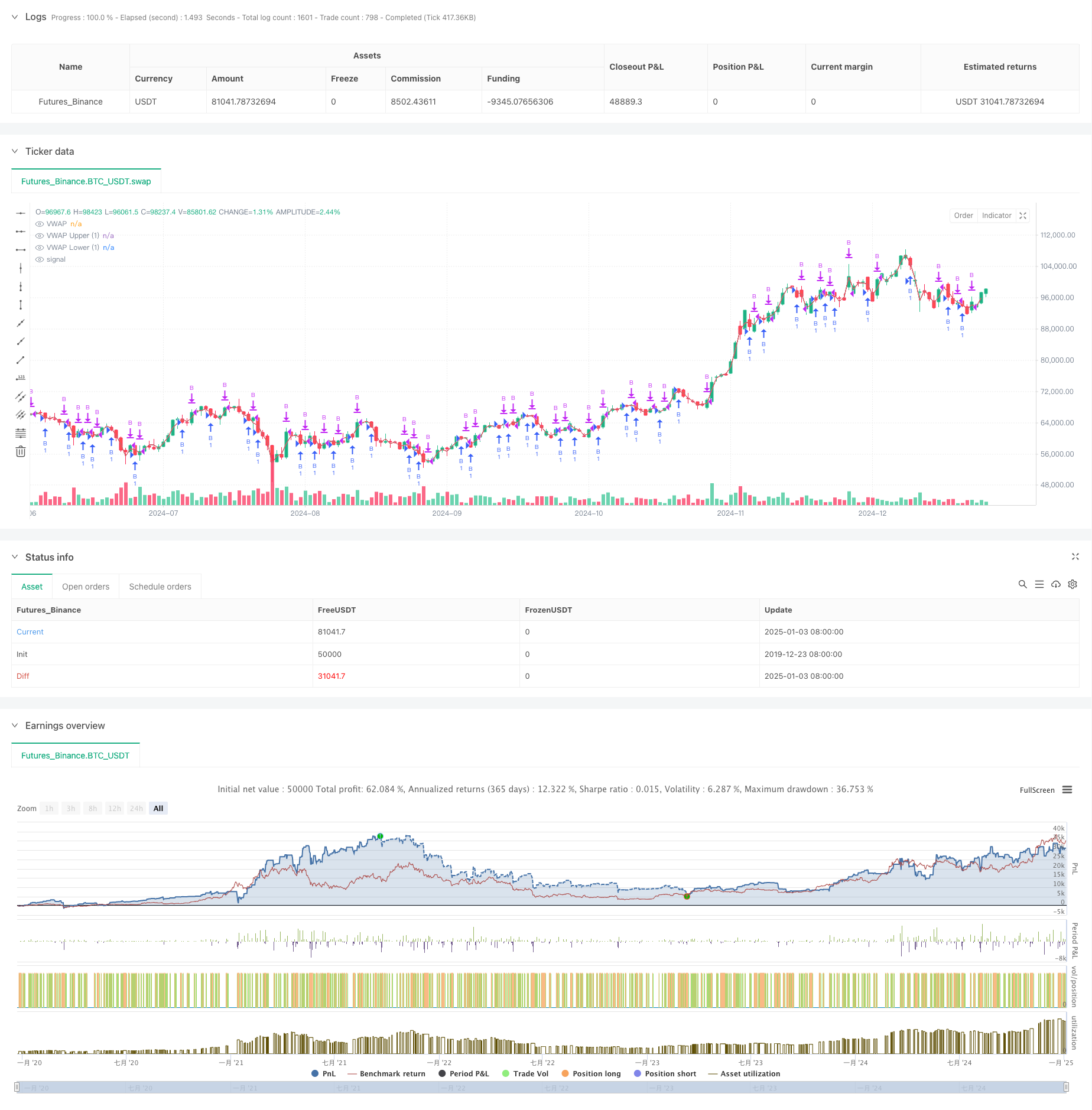
概述
该策略是一个基于VWAP(成交量加权平均价格)和标准差通道的趋势突破策略。它通过计算VWAP和上下标准差通道,构建了一个动态的价格波动区间,用于捕捉价格向上突破的交易机会。策略主要依靠标准差带的突破信号进行交易,并设置了利润目标和订单间隔来控制风险。
策略原理
- 核心指标计算:
- 使用日内HL2价格和成交量计算VWAP
- 基于价格波动计算标准差
- 设置1.28倍标准差上下通道
- 交易逻辑:
- 入场条件:价格下穿下轨后回升至上方
- 出场条件:达到预设利润目标
- 设置最小下单间隔以避免频繁交易
策略优势
- 统计学基础
- 基于VWAP的价格中枢参考
- 利用标准差衡量波动性
- 动态调整交易区间
- 风险控制
- 设定固定利润目标
- 控制交易频率
- 仅做多策略降低风险
策略风险
- 市场风险
- 剧烈波动可能导致假突破
- 趋势转折点难以准确把握
- 单边下跌行情损失加大
- 参数风险
- 标准差倍数设置敏感
- 利润目标设置需要优化
- 交易间隔影响收益表现
优化方向
- 信号优化
- 增加趋势判断过滤器
- 结合成交量变化确认
- 添加其他技术指标验证
- 风险管理优化
- 动态设置止损位置
- 根据波动率调整仓位
- 完善订单管理机制
总结
这是一个结合了统计学原理和技术分析的量化交易策略。通过VWAP和标准差带的配合,构建了相对可靠的交易系统。策略的核心优势在于其科学的统计学基础和完善的风险控制机制,但仍需要在实际应用中不断优化参数和交易逻辑。
策略源码
/*backtest
start: 2019-12-23 08:00:00
end: 2025-01-04 08:00:00
period: 1d
basePeriod: 1d
exchanges: [{"eid":"Futures_Binance","currency":"BTC_USDT"}]
*/
//@version=5
strategy("VWAP Stdev Bands Strategy (Long Only)", overlay=true)
// Standard Deviation Inputs
devUp1 = input.float(1.28, title="Stdev above (1)")
devDn1 = input.float(1.28, title="Stdev below (1)")
// Show Options
showPrevVWAP = input(false, title="Show previous VWAP close?")
profitTarget = input.float(2, title="Profit Target ($)", minval=0) // Profit target for closing orders
gapMinutes = input.int(15, title="Gap before new order (minutes)", minval=0) // Gap for placing new orders
// VWAP Calculation
var float vwapsum = na
var float volumesum = na
var float v2sum = na
var float prevwap = na // Track the previous VWAP
var float lastEntryPrice = na // Track the last entry price
var int lastEntryTime = na // Track the time of the last entry
start = request.security(syminfo.tickerid, "D", time)
newSession = ta.change(start)
vwapsum := newSession ? hl2 * volume : vwapsum[1] + hl2 * volume
volumesum := newSession ? volume : volumesum[1] + volume
v2sum := newSession ? volume * hl2 * hl2 : v2sum[1] + volume * hl2 * hl2
myvwap = vwapsum / volumesum
dev = math.sqrt(math.max(v2sum / volumesum - myvwap * myvwap, 0))
// Calculate Upper and Lower Bands
lowerBand1 = myvwap - devDn1 * dev
upperBand1 = myvwap + devUp1 * dev
// Plot VWAP and Bands with specified colors
plot(myvwap, style=plot.style_line, title="VWAP", color=color.green, linewidth=1)
plot(upperBand1, style=plot.style_line, title="VWAP Upper (1)", color=color.blue, linewidth=1)
plot(lowerBand1, style=plot.style_line, title="VWAP Lower (1)", color=color.red, linewidth=1)
// Trading Logic (Long Only)
longCondition = close < lowerBand1 and close[1] >= lowerBand1 // Price crosses below the lower band
// Get the current time in minutes
currentTime = timestamp("GMT-0", year(timenow), month(timenow), dayofmonth(timenow), hour(timenow), minute(timenow))
// Check if it's time to place a new order based on gap
canPlaceNewOrder = na(lastEntryTime) or (currentTime - lastEntryTime) >= gapMinutes * 60 * 1000
// Close condition based on profit target
if (strategy.position_size > 0)
if (close - lastEntryPrice >= profitTarget)
strategy.close("B")
lastEntryTime := na // Reset last entry time after closing
// Execute Long Entry
if (longCondition and canPlaceNewOrder)
strategy.entry("B", strategy.long)
lastEntryPrice := close // Store the entry price
lastEntryTime := currentTime // Update the last entry time
// Add label for the entry
label.new(bar_index, close, "B", style=label.style_label_down, color=color.green, textcolor=color.white, size=size.small)
// Optional: Plot previous VWAP for reference
prevwap := newSession ? myvwap[1] : prevwap[1]
plot(showPrevVWAP ? prevwap : na, style=plot.style_circles, color=close > prevwap ? color.green : color.red)
相关推荐